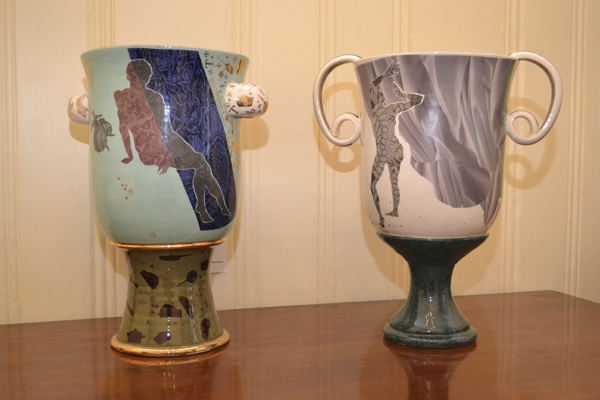We are standing in the wood-panelled anteroom to the state rooms at No. 10 Downing Street — myself, Mo Hussein, David Heaton and Janice Blackburn, the former curator of the Saatchi Gallery who has been putting examples of contemporary decorative art and design into No. 10 since last July. We gaze up at Michael Eden’s Wedgwood Tureen on a high mantelpiece above the fireplace. Eden used to make earthenware pots in deep Cumbria but now he designs with 3D software and his pieces are built layer by layer by a 3D printer. His Wedgwood Tureen is based on a classic Wedgwood shape, translated into a vivid red diagram of the original. It looks like a replication of a familiar object made by intelligent aliens. We are all quietly impressed.
Mo, the senior press officer, points out that thousands of visitors come through Downing Street each year. And I feel that I already know David — the facilities manager — because he and 11 other ‘non-political’ staff selected their favourite Downing Street artworks for the exhibition 12 from Number 10, now at the Whitechapel Art Gallery (until 10 June). David, radically, decided on John Wood and Paul Harrison’s video ‘Twenty Six (Drawing and Falling Things)’ that interrogates the relationship between humans and architecture.
There is impressive fine art of all dates at No. 10 (a beautiful early Lucian Freud landscape at the top of the main staircase, the best version of Thomas Phillips’s ‘Lord Byron in Albanian Dress’ in the Pillared Room and Tracey Emin’s faintly annoying neon ‘More Passion’ sharing space with Michael Eden in the anteroom). But modern craft and design (aside from the Silver Trust’s munificent gifts for the state dining room) are strikingly absent. Blackburn began her campaign to put good design into Downing Street when Gordon Brown was Prime Minister, inspired by a lyrical speech he gave on creative Britain. Letters were sent to his faithful aide Sue Nye but in the end Blackburn had better luck with the coalition government. The culture minister Ed Vaizey likes quoting Ruskin and Morris, cites Matthew Crawford’s libertarian best seller The Case for Working with Your Hands and has sung the praises of the pots of Edmund de Waal and the ceramic installations of Clare Twomey.
Blackburn is a one-woman proselytiser for international new design, but for Downing Street she has chosen strictly British goods. We walk on through the enfilade of rooms, Mo in polite attendance and charming David talking knowledgably about the William Kent furniture in the Pillared Room. Two radiant green and orange glass vases made at the Venini glass factory and designed by Edward Barber and Jay Osgerby sit on a Kent console. Part of the fun is spotting Blackburn’s interventions — which are not always apparent in surroundings that are alternately chintzy and grand.
In the White Room, with its magnificent Turners, Nicholas Rena’s swooping ceramic ‘Figure in Blue’ suddenly leaps out, looking dynamic and poised on a marquetry table under a gilt mirror. In the Small Dining Room two ravishing candelabra by Deborah Thomas turn out to be made of recycled glass. Back on the ground floor there is an unnervingly accurate model of the No. 10 doorway made of sugar cubes by Brendan Jamison. The pokey waiting-room has been given a new waste bin designed by Ron Arad and is adorned with Charlotte Hodes’s figurative collages that are also translated on to a pair of vases inspired by Sèvres.
Blackburn has already included work by the furniture maker Gareth Neal, who, rather like Michael Eden, combines historic forms with digital processes, and by the fiercely intellectual design duo Glithero, whose symbolic-making activities refer back to Victorian industrialisation. Increasingly everything we design in Britain is made elsewhere — and several of the artists Blackburn has chosen are keenly aware of this. Eden, Glithero, Neal and Thomas reflect on lost British manufacturing, on the meaning of work, on recycling and on the social life of things.
As William Blake pointed out, ‘He who would do good to another must do it in Minute Particulars.’ Blackburn’s small, elegant project has introduced large numbers of influential visitors to current work by very young designers and by established figures. By putting a modern equivalent of the 18th-century eye-catcher in the most important public rooms at No. 10 she has done the coalition government a notably good turn, making it seem implausibly cool and connected.






Comments